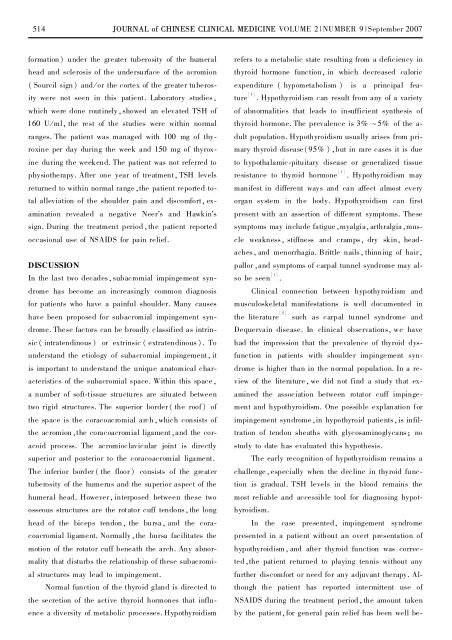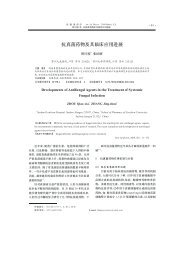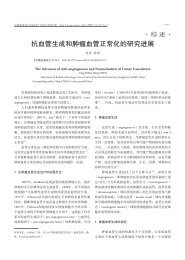Metabolic cause of shoulder impingement syndrome
Metabolic cause of shoulder impingement syndrome
Metabolic cause of shoulder impingement syndrome
You also want an ePaper? Increase the reach of your titles
YUMPU automatically turns print PDFs into web optimized ePapers that Google loves.
514 JOURNAL <strong>of</strong> CHINESE CLINICAL MEDICINE VOLUME 2|NUMBER 9|September2007 formation) under the greater tuberosity <strong>of</strong> the humeral<br />
head and sclerosis <strong>of</strong> the undersurface <strong>of</strong> the acromion<br />
( Sourcil sign) and /or the cortex <strong>of</strong> the greater tuberos唱<br />
ity were not seen in this patient.Laboratory studies,<br />
which were done routinely,showed an elevated TSH <strong>of</strong><br />
160 U /ml, the rest <strong>of</strong> the studies were within normal<br />
ranges.The patient was managed with 100 mg <strong>of</strong> thy唱<br />
roxine per day during the week and 150 mg <strong>of</strong> thyrox唱<br />
ine during the weekend.The patient was not referred to<br />
physiotherapy.After one year <strong>of</strong> treatment, TSH levels<br />
returned to within normal range,the patient reported to唱<br />
tal alleviation <strong>of</strong> the <strong>shoulder</strong> pain and discomfort, ex唱<br />
amination revealed a negative Neer摧s and Hawkin摧s<br />
sign.During the treatment period,the patient reported<br />
occasional use <strong>of</strong> NSAIDS for pain relief.<br />
DISCUSSION<br />
In the last two decades,subacromial <strong>impingement</strong> syn唱<br />
drome has become an increasingly common diagnosis<br />
for patients who have a painful <strong>shoulder</strong>.Many <strong>cause</strong>s<br />
have been proposed for subacromial <strong>impingement</strong> syn唱<br />
drome.These factors can be broadly classified as intrin唱<br />
sic( intratendinous) or extrinsic ( extratendinous).To<br />
understand the etiology <strong>of</strong> subacromial <strong>impingement</strong>, it<br />
is important to understand the unique anatomical char唱<br />
acteristics <strong>of</strong> the subacromial space.Within this space,<br />
a number <strong>of</strong> s<strong>of</strong>t唱tissue structures are situated between<br />
two rigid structures.The superior border( the ro<strong>of</strong>) <strong>of</strong><br />
the space is the coracoacromial arch,which consists <strong>of</strong><br />
the acromion,the coracoacromial ligament,and the cor唱<br />
acoid process.The acromioclavicular joint is directly<br />
superior and posterior to the coracoacromial ligament.<br />
The inferior border( the floor) consists <strong>of</strong> the greater<br />
tuberosity <strong>of</strong> the humerus and the superior aspect <strong>of</strong> the<br />
humeral head.However, interposed between these two<br />
osseous structures are the rotator cuff tendons,the long<br />
head <strong>of</strong> the biceps tendon, the bursa, and the cora唱<br />
coacromial ligament.Normally,the bursa facilitates the<br />
motion <strong>of</strong> the rotator cuff beneath the arch.Any abnor唱<br />
mality that disturbs the relationship <strong>of</strong> these subacromi唱<br />
al structures may lead to <strong>impingement</strong>.<br />
Normal function <strong>of</strong> the thyroid gland is directed to<br />
the secretion <strong>of</strong> the active thyroid hormones that influ唱<br />
ence a diversity <strong>of</strong> metabolic processes.Hypothyroidism<br />
refers to a metabolic state resulting from a deficiency in<br />
thyroid hormone function, in which decreased caloric<br />
expenditure ( hypometabolism ) is a principal fea唱<br />
ture [1]<br />
.Hypothyroidism can result from any <strong>of</strong> a variety<br />
<strong>of</strong> abnormalities that leads to insufficient synthesis <strong>of</strong><br />
thyroid hormone.Theprevalenceis3% ~5% <strong>of</strong> the a唱<br />
dult population.Hypothyroidism usually arises from pri唱<br />
mary thyroid disease(95%),but in rare cases it is due<br />
to hypothalamic唱pituitary disease or generalized tissue<br />
resistance to thyroid hormone [1]<br />
.Hypothyroidism may<br />
manifest in different ways and can affect almost every<br />
organ system in the body.Hypothyroidism can first<br />
present with an assertion <strong>of</strong> different symptoms.These<br />
symptoms may include fatigue,myalgia,arthralgia,mus唱<br />
cle weakness, stiffness and cramps, dry skin, head唱<br />
aches, and menorrhagia.Brittle nails, thinning <strong>of</strong> hair,<br />
pallor,and symptoms <strong>of</strong> carpal tunnel <strong>syndrome</strong> may al唱<br />
so be seen [1]<br />
.<br />
Clinical connection between hypothyroidism and<br />
musculoskeletal manifestations is well documented in<br />
the literature [5]<br />
such as carpal tunnel <strong>syndrome</strong> and<br />
Dequervain disease.In clinical observations, we have<br />
had the impression that the prevalence <strong>of</strong> thyroid dys唱<br />
function in patients with <strong>shoulder</strong> <strong>impingement</strong> syn唱<br />
drome is higher than in the normal population.In a re唱<br />
view <strong>of</strong> the literature, we did not find a study that ex唱<br />
amined the association between rotator cuff impinge唱<br />
ment and hypothyroidism.One possible explanation for<br />
<strong>impingement</strong> <strong>syndrome</strong>,in hypothyroid patients,is infil唱<br />
tration <strong>of</strong> tendon sheaths with glycosaminoglycans; no<br />
studytodatehasevaluatedthishypothesis.<br />
The early recognition <strong>of</strong> hypothyroidism remains a<br />
challenge,especially when the decline in thyroid func唱<br />
tion is gradual.TSH levels in the blood remains the<br />
most reliable and accessible tool for diagnosing hypot唱<br />
hyroidism.<br />
In the case presented, <strong>impingement</strong> <strong>syndrome</strong><br />
presented in a patient without an overt presentation <strong>of</strong><br />
hypothyroidism, and after thyroid function was correc唱<br />
ted,the patient returned to playing tennis without any<br />
further discomfort or need for any adjuvant therapy.Al唱<br />
though the patient has reported intermittent use <strong>of</strong><br />
NSAIDS during the treatment period,the amount taken<br />
by the patient,for general pain relief has been well be唱
















